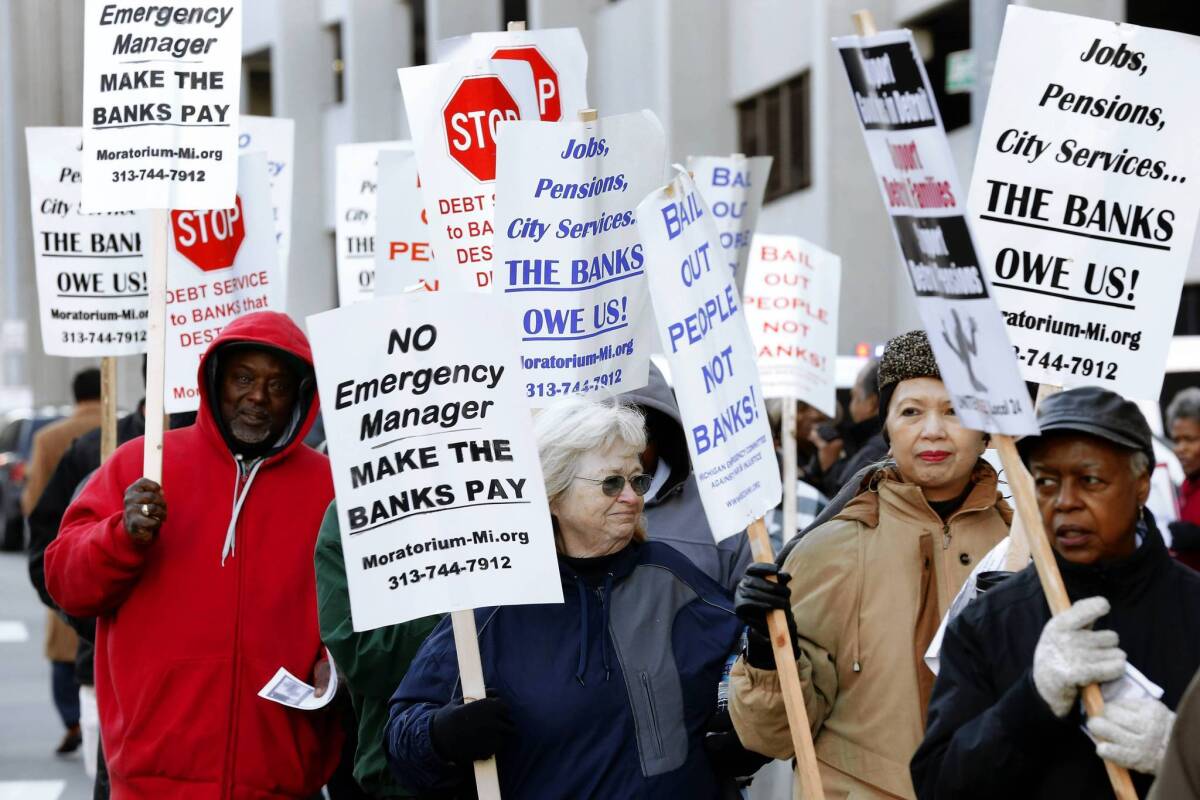Detroit’s bankruptcy brings up more than finances

DETROIT — Sheilah Johnson was a building inspector for the city for 28 years, a college graduate who passed up jobs that paid more because a city job offered stability and the promise of a good pension.
But the city’s recent plunge into bankruptcy — overseen by an outside emergency manager answerable to the state government, not the citizens of Detroit — makes her wonder whether she and other African American residents of the impoverished city will be able to stop Wall Street creditors from seizing what’s left of a municipal treasury they paid into for most of their lives.
“When my 9-year-old grandson asks me, ‘Grandma, are they trying to make us slaves again?’ how do I answer that child?” Johnson said, breaking into tears during court hearings over the city’s bid to launch the nation’s largest-ever municipal bankruptcy. “We do not need a slave owner, and I am not a slave.”
Much of the trial to determine whether this onetime powerhouse of the American economy is eligible for bankruptcy has focused on such nuts-and-bolts issues as debt structuring and pension liabilities. But the issue of race has hovered persistently around the trial, which wrapped up Friday. The move to secure and sell off remaining assets — including art museum treasures and valuable real estate — was portrayed by many African American residents who showed up in court to try to halt the bankruptcy as neocolonial plundering.
They said possible cuts to public pensions would disproportionately target black workers who were left with nothing but government jobs after industry fled, along with most white residents, to the suburbs. Racial tensions were only inflamed a week ago when a white man shot and killed a black woman who was seeking help after her car broke down in a suburb.
“There are two big elephants in this courtroom — race and democracy — and that’s what makes this whole case a little bit different from the typical bankruptcy case I endured during my tenure as a law student,” said Sam Riddle, a political consultant who has followed the case.
U.S. Bankruptcy Judge Steven Rhodes said he would rule after additional briefs are filed next week on whether the city can remain under federal bankruptcy protection. City unions and retired employee groups — organizations with large African American representation — have argued that the bankruptcy is an attempt to get around a ban on pension cuts in the Michigan Constitution.
In Detroit, which last week elected its first white mayor in four decades, it is nearly impossible to escape discussion of race. The city’s population is 82% African American, in a state that is 79% white.
That division began in 1943, when a race riot that lasted for days drove the first waves of residents out of the city, a move exacerbated by riots in 1967 in which 43 people died. Now, Detroit is considered the most segregated metropolitan region in the country.
“You can drive around now and not see a white person all day long,” said the Rev. Charles Williams II, who watched much of the trial and was one of nearly 1,000 protesters outside the court last month.
Demonstrators argued that the bankruptcy should be halted and Detroit residents left to determine a way to rescue themselves from debts that now total an estimated $18 billion.
Among the most highly charged issues is Michigan’s emergency manager law, which the National Assn. for the Advancement of Colored People unsuccessfully challenged in court. Under the law, a state-appointed administrator — who is African American, but whose authority comes from white Republican Gov. Rick Snyder — has assumed power from the elected City Council.
“I find this law to be racist in its aims and in its application,” said longtime city resident Bill Hickey, 68, a retired insurance worker who testified during the court hearing. Though he is white, he said the attempt to seize control of the city from elected black leaders had racial overtones: “We have not had any say in this, and this is unjust and unfair.”
Many residents also have been critical of the state’s withdrawal of some of the financial support that it once gave the city, and the fact that the state applied for permission to pay back a loan to a bank before it makes pension payments.
Why, they wonder, have Michigan residents seemed to blame Detroit’s problems on bad leadership by some of its past mayors, who were black, while expressing so much optimism about the election of a white mayor?
“We still remember — we haven’t forgotten — that we are only a few footsteps away from slavery,” said Monica Lewis-Patrick, a community activist who works at Hush House, a shelter in one of Detroit’s most embattled neighborhoods.
Many in Detroit would strongly disagree with the race narrative. After all, statistics alone highlight just how much Detroit needs help, from wherever it comes: The city, whose population has declined 63% since its postwar peak, has the highest violent crime rate of any big city; 40% of its street lights don’t function.
Without state intervention and bankruptcy, say those advocating the process, Detroit would not have been able to reorganize its finances or continue to function.
“Ultimately it was determined this municipal Chapter 9 bankruptcy filing was simply the last viable option and was in the best interests of the people of Detroit and our state — to solve the financial crisis six decades in the making,” said Sara Wurfel, a spokeswoman for the governor. “Gov. Snyder believes deeply that he represents, and is accountable to, all Michiganders regardless of where they live or certainly what color their skin is.”
But the question of whether Snyder and the emergency manager he appointed represent the interests of the majority of Detroit residents is at best controversial.
When Snyder testified during the trial, a handful of African American residents watched from an overflow room, sometimes scoffing when he said he couldn’t remember whether he had discussed the future of city pensions with emergency manager Kevyn Orr. Others called Orr an “overseer,” referring to black managers of white plantations during slavery.
The listeners included Cecily McLellan, who worked for the city for 28 years and tried to attend as much of the trial as possible. McLellan, who is black, believes Snyder would never appoint an emergency manager for a white suburb, such as affluent Grosse Pointe or Troy, even if their finances were as troubled as those of Detroit.
The racial divide is evident in the drive from her block, where many nearby houses have been abandoned, to the courthouse downtown. Her neighborhood’s downfall was rapid, she said, and happened as the city’s finances deteriorated. Funds to tear down houses, to keep retirees in their homes and to keep the heat on during winter all disappeared.
On her way to the courthouse, McLellan passes a small revitalized area of a few blocks with a Whole Foods store, a yoga studio and a few coffee shops. There, developers have spent millions in the last few years. Many young white professionals now live in the neighborhood.
Some days, McLellan takes a loop through Belle Isle, a city park open to all Michiganders. Anyone can still come to Detroit to use its parks and see its sports teams, she said, but were she to drive to the suburb of Grosse Pointe, she wouldn’t be allowed in its parks. Only residents with ID cards are allowed in.
“You’ve got folks internalizing that all the problems with Detroit are because of the black population that lives in Detroit,” McLellan said. “But in reality, all the factories moved out to the suburbs, all downtown up and moved, and they took the economy out.”
The result: More than a third of the city’s 700,000 residents now have incomes below the poverty level. Per capita income is just $14,000. And the librarians, trash haulers, teachers and police officers who have depended on public paychecks now see even those lean futures at risk.
Detroit, McLellan said, is reminiscent of New Orleans, another major U.S. city where African Americans were left powerless to fend off disaster. “It’s another Katrina-type situation,” she said.
No one can discuss Detroit’s future without talking about race, Hickey said. Some may think that with the election of President Obama and Detroit Mayor-elect Mike Duggan, such problems can be forgotten. But Hickey fears racial inequalities might just get worse as the city tries to set itself right.
“We want to feel like we’re in a post-racial situation, and that black people should ‘get over it,’” he said. “But racism is still a huge issue. It’s a hard conversation to have, but it’s an important one, and we need to have it.”
More to Read
Start your day right
Sign up for Essential California for news, features and recommendations from the L.A. Times and beyond in your inbox six days a week.
You may occasionally receive promotional content from the Los Angeles Times.







